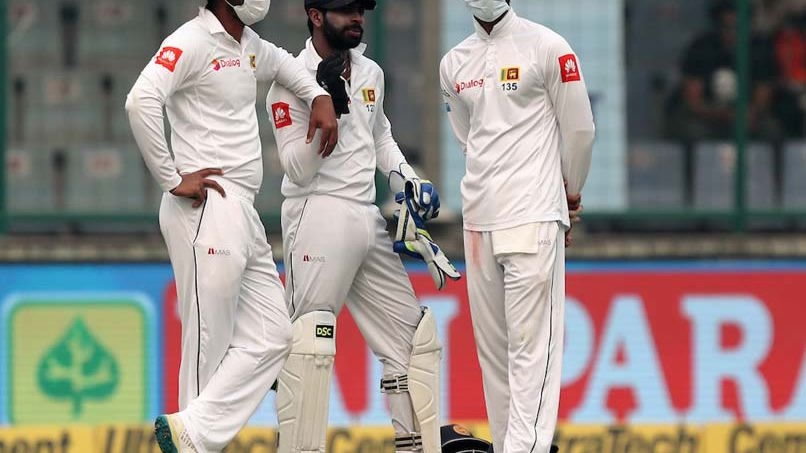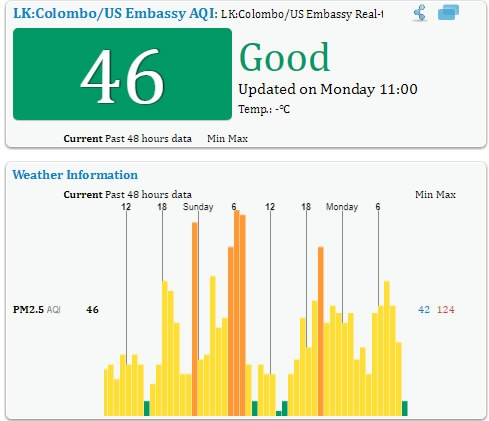
World
17:13, 04-Dec-2017
Air pollution halts international cricket match in Delhi
Alok Gupta

Two scoreboards have been steadily ticking upwards in New Delhi.
While the worsening Air Quality Index (AQI) has hit “hazard” levels, Indian and Sri Lankan batsmen playing a cricket Test match in the notoriously smoggy city have been scoring runs. The game had to pause for a breather on Sunday, with toxic air disrupting play twice.
Commentators announced that it is for the first time that the bad air quality has disrupted an international cricket match. Sri Lanka and India have locked horns for the third Test match at Feroz Shah Kotla stadium.
On Sunday after lunch, haze worsened forcing the fielding side Sri Lankan players to wear masks, they complained to umpires about the toxic air and poor light halting the match for nearly 20 minutes.
The game was again disrupted as bowlers Suranga Lakmal, and Lahiru Gamage left the field complaining of breathing problems.

Air pollution level in New Delhi has been extremely high. /AQI Screenshot
Air pollution level in New Delhi has been extremely high. /AQI Screenshot
The match resumed on Monday with Sri Lankan players again complaining about the toxic air. Barely two hours into the game, National Green Tribunal (NGT) issued a statement criticizing the Delhi Government and other authorities for allowing a cricket match during "hazardous" air quality.
India’s AQI vs. Sri Lanka’s AQI
According to the Central Pollution Control Board, the particulate matter (PM) 2.5 level, small particles that enter bloodstream and lungs, and PM 10 level, inhalable particles, were nearly four times higher than the safe limit.
New Delhi is notorious for extremely high air pollution. Last year's regional level domestic Ranji cricket matches were canceled after smog worsened.
This year, the Indian Medical Association (IMA) had advised the Delhi government to close schools and cancel a half-marathon event. Severe smog had also forced United Airlines to cancel flights.
In a desperate move, the government even planned to fly helicopters that sprayed water to control the raging smog. But the thick blanket of smog couldn’t let the chopper take off.
The AQI level on Monday at 10 a.m. in New Delhi was even worse. The real-time data saw PM 2.5 levels hovering at 632 and PM 10 levels were 999. The World Health Organization (WHO) advisory warns against any outdoor activities when the PM level crosses the 300 mark.
A section of the high ranking official from the Board of Control for Cricket in India (BCCI) accused Sri Lanka players of being oversensitive towards air pollution.
“If 20,000 people in the stands did not have a problem and the Indian team did not face any issue, I wonder why [the] Sri Lankan team made a big fuss. I will need to talk to the secretary and ask him to write to the Sri Lanka cricket,” BCCI acting president CK Khanna told PTI.

However, Sri Lanka’s AQI shows an healthy air quality throughout the year.
The real-time air quality data in Colombo showed ambient air quality at 46 with PM 2.5 level at 42. Despite booming vehicle sales, the country has been able to maintain ambient air quality.
Annually, the average PM 2.5 level in Sri Lanka is between 21-29, much below the national standard that has been set at 50. PM 10 in the country hovers between 23-35, while the national standard is at 100.
Concerned over the players inability to adjust to intense air pollution level in Delhi, Sri Lankan team's coach Nic Pothas told ESPN, "That (future course of action) is in the hands of match referee and umpires, and I am sure they will have meetings tonight and try and put together some sort of precedent if that happens tomorrow again."
Despite smog, the Indian captain, Virat Kohli scored 243 runs on Sunday, his second double ton. India declared at 536/7.

SITEMAP
Copyright © 2018 CGTN. Beijing ICP prepared NO.16065310-3
Copyright © 2018 CGTN. Beijing ICP prepared NO.16065310-3